The Annual Physical: Working adult Soay sheep with a kit
Once we are past lambing and the pumps are in the river, ready to start irrigating the pastures, we turn our attention to the Bull Pen. Other than occasional wormings, putting hay in their feeders in the winter, and for the lucky few, fall action, the rams are pretty much on their own year-round. Their Annual Physical in June usually is the only time we get a good look at each of them up close.
Regular readers already familiar with our fixation on routines and data will not be surprised to learn we have both an Adult Kit and an Annual Physical Check List, same list and kit for ewes and rams, mostly.
From a distance, the lamb and adult kits also look pretty much the same: green rectangular box that sits on the fence, towels, syringes. But there the similarity ends. Here is our Adult Kit spread out on the workbench for loading.
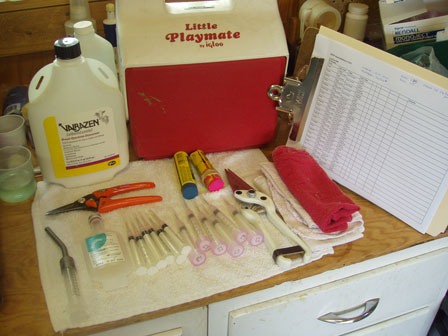
In clockwise order, starting with the white bottle in the upper left corner:
Valbazen. One of two wormers we use, switching from time to time to minimize the buildup of immunity in the resident worm population. Whether or not you need to worm, and how often, is up to you and your vet to decide. We take a composite stool sample in once a year to see what we are up against and go from there.
Cooler. Because we vaccinate when the outdoor temperatures are well above 40 degrees and it sometimes takes a long time before we inject, we need to keep the Covexin-8 cold. While Steve gets the rams (or ewes) rounded up, I load a syringe for each animal with 2 cc of Covexin (the dosage listed on the bottle is way too much for little Soay sheep) and place them in a small beer cooler with a few ice cubes, leaving the big bottle of Covexin behind in the refrigerator while we work the sheep. You can use fake ice packs, but if you are doing a lot of sheep, the Covexin-loaded syringes will start to freeze. Since the syringes can be purchased very inexpensively in bulk from Jeffers, pre-filling one for each animal prevents degradation or contamination of the large (expensive) bottle of vaccine and also helps prevent the direct transfer of disease organisms between animals from re-using needles. It took Steve awhile to recalibrate from the squeaky clean, sterile lab environment he was used to when he was a bench scientist to the realities of a barnyard, but he still cannot stand re-using a syringe when it costs only a dime. You can see the syringes laid out here for filling, with the actual vaccine bottle to the left.
Marking pens. Right there below the cooler are two paint sticks, one to indicate Covexin has been administered and one that worming was done. Many of the pictures of our animals on our farm website and the OFP Gallery show faces with green or yellow or blue or pink stripes, signifying nothing more earth-shaking than that I took the pictures while we had the sheep confined for their physicals.
Clipboard. Holds the ever-present list, discussed below.
Rags and towels. Until recently, we used them only for cleanup. But they also make good blindfolds as I will tell you about in a separate post. This thing is getting too long already.
Hoof trimmers. As you can see, I loaded up both the big white trimmer and the smaller red one over on the left. Turns out Steve never uses the big one because he learned the smaller one allows him to get into smaller flaps of overgrowth with less risk of cutting too deep. If you own the big hulks like Suffolk sheep, the larger trimmer will work just fine. More on hoof trimming in a separate post as well.
Wormer applicator. I did not organize the contents very well, did I? Way over on the lower left is the last component of the Adult Kit, a clear plastic “syringe” with a grey open-tube applicator. An easily-washed gadget, it is sold by Premier as a “drencher.” You also can easily make your own drenchers by taking the needle off a syringe and replacing it with a short piece of clear plastic tubing. We keep several in different sizes on hand for things like a quick shot of Pepto Bismol for diarrhea. I forgot to include in this picture a short plastic disposable (highball?) glass I use to pour out enough wormer for several animals. Taking this extra step means I do not put the dirty applicator back into the sterile bottle of wormer for re-filling. And besides, I have not figured out how to get the applicator down into the big bottle without smudging the icky worming solution all over my hands. Fussy? You bet.
The working list. We just cannot say enough about the value of having a list to work from. A plain name list with tag numbers will do, but boredom will set in quickly. Because Steve keeps detailed data on each of our Soay, it is just as easy for him to print out birthdates and parents along with tag numbers.
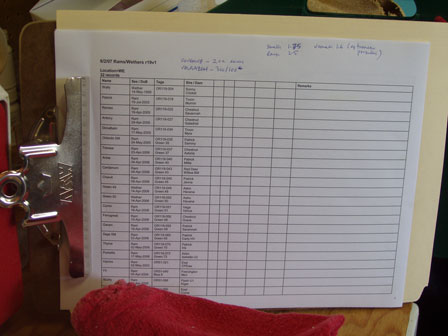
For us, one of the most quietly satisfying, oftentimes humorous parts of shepherding is simply talking about our animals and how they look and act while we are working them. We almost always end up with a number of questions and data treasure hunts to go on. Especially with our rams, the Annual Physical is the best time to observe, discuss, and record growth changes and the appearance (or not) of family resemblances. This time, for example, we noted that Antony’s horns have grown to magnificent arches, very wide as are his sire Chestnut’s horns, but with less ribbing. At one year, Antony had okay horns, but his second year of growth must have been unusually robust or we simply were not paying attention while he grew his rack. He also has taken on the graceful body contours of his dam, Galadrial. I think it is time to brag on this fellow, so I am going to take you through his baby album. Here he is as a cute newborn with his twin Cleopatra and his dam. Antony’s on the right.
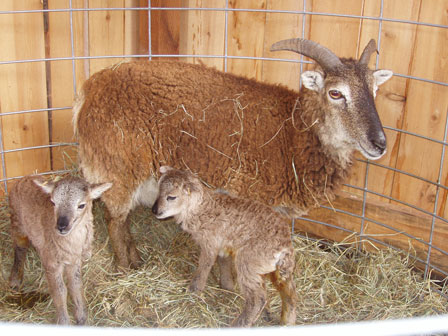
As a youngster, he was nice looking but nothing you would enter in a GQ contest. Again, he is with his twin and he is on the right.
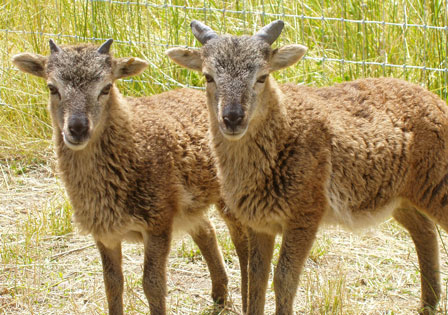
At about one year, he was starting to get respectable horns and the same little white beard as his sire. I took this picture one day when all our rams were snoozing and I was able to walk among them without disturbing their naps.
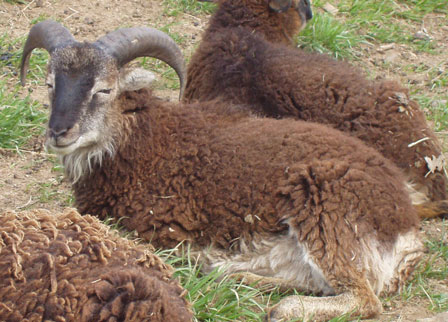
Finally, here is a picture of Antony in all his horned glory, taken this spring while we were working the rams, fresh from rooing off his winter coat and looking mighty sleek.
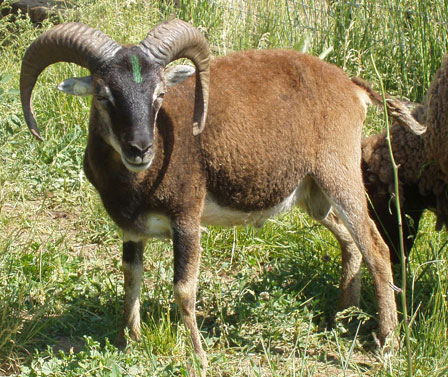
Seeing Antony up close and marveling at his looks sent us right back to his pedigree to see if we can get more like him – ewes or rams! Turns out there are reasons beyond compulsion with data to spend time out with these elegant sheep.
For now …